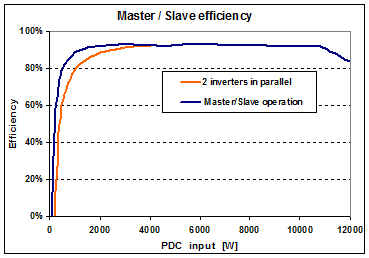|
<< Click to Display Table of Contents >> Inverter model: multi-MPPT |
  
|
|
<< Click to Display Table of Contents >> Inverter model: multi-MPPT |
  
|
Multi-MPPT inverters
Many inverter models have several MPPT inputs, each usually with identical specifications.
In PVsyst, during the simulation, a multi-MPPT inverter is treated as several independent (identical) inverters. For example a 10kW inverter will be equivalent to two 5 kW inverters.
Now with this hypothesis, if you put a different number of PV modules on each input, you can have overload losses on one input and not on the other one. In the real multi-MPPT inverters, the limitation is active for the global PNom of the inverter, i.e. the nominal power may be shared between the inputs.
Since the version 6.33 of PVsyst, this behavior may be taken into account by attributing manually a specified PNom for each input, provided that the sum remains the Pnom of the inverter.
See Multi-MPPT inverters use in sub-arrays.
Unbalanced MPPT inputs
Some few special inverters have two different MPPT inputs: one for the main part of the modules, and one receiving a single string with any number of modules (within the voltage limits). This is a very interesting configuration, as it allows to connect virtually any number of modules to a single inverter: the "Main" inputs has a homogeneous product (for example 3 x 20 modules), and the "Secondary" receives the rest of the modules to be installed.
In PVsyst, these inverters are specified as Unbalanced MPPT inputs, and are treated in a specific way.
PVsyst defines the Main and the Secondary inputs (only 2 inputs are possible), specified by their maximal current (usually the current of the secondary is suited for one string of 6" cells modules).
At the design time, the PNom of each input is shared according to the maximum currents specified for each input.
At the simulation time, the PNom is reassigned according to the PV modules power effectively connected to each input. Therefore you will not have "dissymetric" overpower losses.
See Multi-MPPT inverters use in sub-arrays for details.
Master/Slave operation
The Master/Slave operation is a specificity of some few inverters.
In this mode, the array is connected to the inputs of 2 inverters, but only one of them (the Master) is performing the MPP tracking on the array, and transmits information to the second one (the Slave).
The Master begins to operate alone, until the array available power overcomes a given threshold (usually its own PNom). Therefore it operates better under low powers. The gain may be of the order of 1 to 2%, lower with modern high-efficiency inverters. The global efficiency curve will be enhanced in the following way (example of 2 inverters of 5 kW each):

NB: many big inverters in the MW range are in fact an assembly of units of 100 to 200 kW, which internally operate in Master/Slave mode. But as "seen" from outside, this improves the efficiency curve (which has a very sharp low-efficiency knee). But the simulation has to treat these devices as a whole, as a conventional inverter.
Connexion of the PV array to the inverter
Be careful: As a general rule, you should never connect several MPPT inputs in parallel: each one should be an independent circuit, otherwise you will have coflicts for the MPP tracking.
As a contrary with Master/Slave mode, you have to connect the array to both inverter inputs, as each inverter should "see" the whole array.